Queens of the Court: Chris Evert, Never Count Out The “Ice Maiden”

Always keeping her eye on the prize, Chris Evert won at least one major for 13 straight years.
As half of one of the greatest sports rivalries of all time, Chris Evert is probably the “half” less appreciated today.
Her battles with Martina Navratilova grew to legendary status as they met so often in the finals of majors. The fact that Navratilova’s career extended years beyond Evert’s is the reason the Czech-American is better known today.
Evert was a powerful baseline player and Navratilova had the ultimate serve and volley game. They battled during an era when these two playing styles clashed on tennis courts around the world.
But there was something else different between these two champions—their on court demeanor and individual personalities were as opposite as night and day.
The one thing they did share in common was an ultimate drive and a fervent determination to be the No. 1 tennis player in the world.
Knowing her, you have to believe that when Christine “Chris” Marie Evert was born on Dec. 21, 1954, she must have come into the world with a tennis racket clutched in her tiny little hand. Thank goodness her mother never had to endure such a handicap. Mom simply had to contend with family members whose lives revolved around the sport.
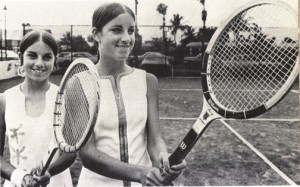
Evert was pre-ordained to be a tennis superstar.
Evert’s father Jimmy was a tennis professional and coach. Thus reared in a tennis-dominated environment, Chris began playing at a very early age, enabling her to find success on the professional tennis stage by the tender age of 15.
She was known first as the “Ice Princess” and later as the “Ice Maiden” because Evert remained completely stone-faced on court—unflappable, stoic, and determined.
“Chrissie” Evert’s pre-ordained illustrious tennis career allowed her to leave her indelible mark on the women’s game in the ’70s and ’80s, when women’s tennis became a sport with a worldwide audience.
Evert’s tennis career
Early on, her talent, discipline, and drive compelled her to stretch and reach for the top rung. Evert grabbed hold and never let go until forced, hanging onto every opportunity like a fierce terrier.
Case in point—she never lost a first or second round match in a major tournament. Evert simply refused to lose.
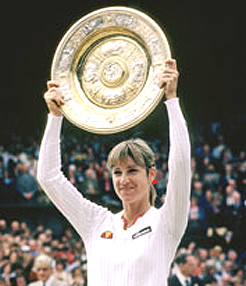
Evert never lost in the first or second round of a major championship and claimed 18 Grand Slam singles titles.
During her tenure at the top of the women’s game she won 18 Grand Slam titles in singles—seven French Opens, six U.S. Opens, three at Wimbledon, and two Australian Opens. Her record of six U.S. Open titles still stands and her win-loss record of 90 percent remains the best of any male or female who played professional tennis.
In her career Evert won 157 titles in singles and in doubles she won three Slam championships and 29 regular tour titles. She was ranked world No. 1 in 1975, 1976, 1977, 1980, and 1981.
Evert’s career spanned almost 20 years and she played the best players in different eras, from Margaret Court and Billie Jean King to Steffi Graf and Monica Seles. Through it all, Evert remained remarkably competitive displaying consistency and discipline—her demeanor forever implacable.
The beginnings
At age 16, Evert made her grand slam debut at the 1971 U.S. Open, where she mowed down the competition on the way to the semifinals. There she met and was defeated by Billie Jean King 6-3, 6-2.
Not too shabby for a teenager taking her first tentative step into the limelight. Back in those days, there were no teenagers playing professional tennis, much unlike today.
In 1973 she improved, ending up as a runner-up at both the French Open and Wimbledon. In 1974, she won both of those events.
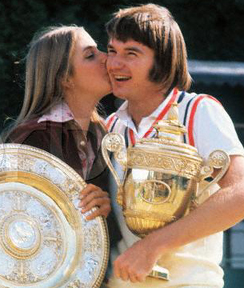
Evert was briefly engaged to tennis bad boy Jimmy Connors.
It was at this time that Evert and fellow American Jimmy Connors were engaged and “love” followed them around like the press, hot on their heels. The romantic duo played “mixed doubles” together at Wimbledon and then later at the U.S. Open in 1974.
For Evert, time spent playing doubles was short-lived, as was her relationship with Connors. She preferred to concentrate her time and training energies upon her singles career.
For the next five years, Evert dominated the women’s game. In 1975 she won the French Open again and captured the U.S. Open, a title she would win for the next four consecutive years. In 1976, she took back the Wimbledon crown.
As Evert reigned supreme on the tennis courts, she was being called “the Ice Maiden” of tennis. Today we might have called her “The Terminator.”
The Evert-Navratilova Rivalry
In the later ’70s, a new rival was pushing her way onto the scene: Martina Navratilova. The young lady from Czechoslovakia made her way to the top of the game, where she inevitably met Evert.
At first, Evert dominated their matches. Navratilova did not like losing. It got under her skin and motivated the Czech. It pushed Navratilova to lose weight, get in shape, hire a coach, and go after the American.
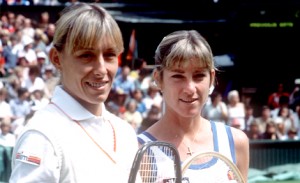
Evert and Martina Navratilova provided tennis with a compelling rivalry in the 1980s.
Evert was smart and she played smart. She possessed a powerful two-handed backhand, one the best in the game. If you ventured to the net, Evert had the ability to pass you on either side.
With excellent speed and footwork, she used her entire arsenal to defeat Navratilova early on in their rivalry.
Eventually, however, Navratilova became the dictator with her fast-paced serve and volley style of play, paralleling the rise of McEnroe who overcame Borg’s dominance on the men’s side.
But consider this: Borg and McEnroe played each other 14 times in their great rivalry. Evert and Navratilova played each other 80 times from 1973-1988, a course of 15 years.
As their matches grew tighter, Evert became more focused, more consistent, patient and more determined. Navratilova grew more agitated, volatile often arguing with the chair umpire, quipping, and joking with the crowd.
The rivalry between Evert and Navratilova became the central spoke of the women’s game in the ’80s as the rivals bore the brunt of building the women’s game. While they each had their fans and their detractors, overall, their rivalry was a positive in building a fan base for women’s tennis.
Like Borg, Evert’s game was best suited for clay where she dominated. From the beginning in 1973, Evert won 125 consecutive matches on clay, losing only seven sets. Her record stands today as the best among men and women.
It ended in 1979 at the Italian Open when Evert lost to Tracy Austin. One suspects that her record on clay of 197-1 from 1973 to 1981 will never be broken.
One wonders how Borg might have fared in comparison, had he continued to play. Certainly on clay no one could ever equal the “Ice Maiden” Evert—not even the “Ice Man” Borg.
In all, she won seven French Open titles. In the process, Evert had to defeat Navratilova three times in three-set matches at French Open finals.
Over the course of their rivalry, Evert faced Navratilova in 14 Grand Slam finals, losing 10 of them. “Chrissie” played best on clay and on hard courts. Navratilova’s best surfaces were grass and indoor carpet.
Overall, Navratilova holds the edge in their head-to-head meetings 43-37. The win-loss difference, however, must take into account the number of times they met on their preferred surface.
Conclusions
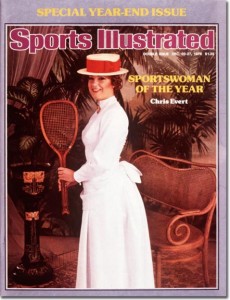
Evert's popularity transcended tennis in the 1970s.
Evert holds the record at the U.S. Open for the most wins in singles, with 101. She won at least one major each year for 13 consecutive years between 1974 and 1986, highlighting her mastery of consistency and focus.
Her legacy is firm, rooted in the core of her belief in herself and her game.
In 1989 Evert retired from professional tennis. Her last match came against Conchita Martinez in the 1989 Fed Cup. In 1995, she became only the fourth player ever elected unanimously into the International Tennis Hall of Fame.
Evert has remained active in tennis by teaching, coaching, and writing. Her impact on the game has been well documented. Evert’s career and her rivalry with Navratilova came at the most opportune time after Billie Jean King co-opted the women’s tour and got it up and running.
Evert’s domination, with her pure strokes, pinpoint placement, and stern countenance became the perfect foil for the colorful and often irascible Navratilova.
Together they became the popular staple on the women’s tour, building for future rivalries and leading the way to today’s game.
To read about the other “Queens of the Court” who helped build the game, follow the links listed below:
Personal blogs are going downhill nowadays, looks like most people run them to earn a living
Added this to FB wall, very interesting!
She is the most stunning player ever and she has been my ideal for the game of tennis. She has really been able to get the respect that she was worth of and she is an example for the ladies that are having talent.